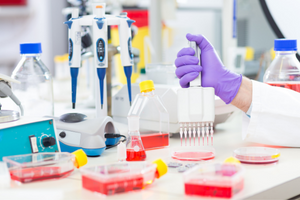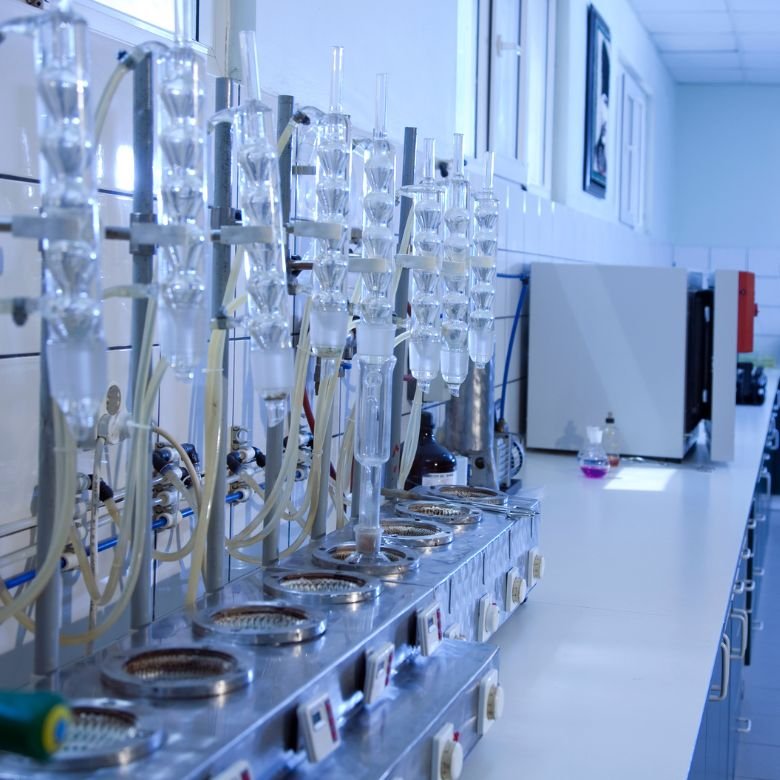The laboratory is a place where we conduct experiments that require specifically controlled conditions. It may be a small room or a large hall, but the most important is what is inside. Obviously, the equipment present in a laboratory may vary depending on its speciality. Even so, there are many instruments which are universal and required in any type of chemical experiments centre. Basic equipment can be divided by the material it is made if: glass, metal, wood, porcelain, rubber and plastics.

Glass laboratory equipment
Depending on its type, glass may be used to produce many essential laboratory instruments. The most popular type, borosilicate glass, satisfies all the requirements, including high thermal resistance and low thermal expansion as well as resistance to organics, acids and bases. The basic equipment components made of glass include test tubes, beakers, flasks, funnels, crystallisers, watch glasses, measuring cylinders, bottles, pipettes and biurets. Glass items can be interconnected with the use of ground joints, that is special endings. Additionally, each ground joint has its specific plugs. This helps not only in simple activities, such as preparing solutions, but also in building instrumentation necessary in, for example, distillation processes or measuring the condensation point.
The most popular laboratory glassware are test tubes, which are narrow, cylindrical vessels used to conduct chemical reactions and to heat small amounts of substances.
Other very important elements are beakers. They have many types and capacities, which are selected as required. Beakers are usually chosen for their capacity, whereas flasks have particular applications. Conical flasks without a ground joint are mostly used for titration, in conical flasks with a wide neck we can evaporate a formulation, while a conical flask with a ground joint often serves as a receiver, for example when collecting a particular distillation fraction. There are many commercially available round-bottomed flasks, which are commonly used in reactions carried out at a high temperature or under a reduced pressure. These include low-capacity heart- and pear-shaped flasks, one-neck round-bottomed flasks as well as two- and three-neck flasks, which allow for extracting or supplying reagents or gases during a reaction.
Watch glasses are particularly useful for covering beakers, but also for conducting colour reactions and weighing solid substances. The glasses are also often used for visual assessment of the product.

Crystallisers are instruments with a cylindrical shape and flat bottom, which mostly serve as vessels for slow evaporation of the solvent during re-crystallisation. A similar vessel but smaller in size is the Petri dish. Its shape is similar to a crystalliser, but it has two parts: a smaller and a bigger dish used as a cover. The dishes can be applied for smaller amounts of crystallisation, but they are mostly used in microbiological laboratories for breeding microorganisms.
Measuring cylinders include a measure, and their calibration allows for measuring a specific portion of liquid as per the adopted accuracy.
Glass rods are used for mixing the contents of, mainly, beakers and conical flasks. Pipettes are glass tubes with a narrowed ending, which are used for precise measuring and transferring of liquids. In quantitative analyses, one- and multi-dimensional pipettes are of particular importance. The third type, Pasteur pipettes, are normally used for adding liquid portions in drops.
The last two important glass elements are funnels and condensers. Funnels are often used for filtering suspensions with appropriate filters or for the quantitative transfer of substances into narrow-neck vessels. A more specific type are filtration funnels with sintered glass, they have a porous sinter at the lower part of the cone or at the top of the foot, which is particularly useful when filtering small amounts of sediment.
Condensers are an essential component of any set of instruments used for changing the physical state from gas into liquid. Their design assumes the application at high temperatures, hence their resistance is higher. This is because inside of the condensers hot vapours get in contact with a coolant. Condensers usually have two ground joints: one allows for connecting the condenser with, for example, a round-bottomed flask containing the substance being distilled, while the one located on the other side can be connected to a liquefier and receiver. Depending on the flow of the condensate (cooled vapour), we distinguish flow condensers and reflux condensers.
Another very important element in almost any laboratory is the biuret, which is designed for measuring specified amounts of liquids, calibrated for outflow. It is necessary for titration analyses.

Weighing bottles and crucibles are used, respectively, to perform analyses at high temperatures existing in dryers (approx. 110oC) and in muffle furnaces (approx. 600oC), such as the determination of weight loss after drying, or the assaying of sulphated ash.
Metal equipment
Metal is often used for additional elements designed for holding, tightening or hanging other devices. The most common metal devices are clamps, which hold glass elements on a stand, i.e. a heavy element serving as a base for building a set of glass instruments. Pliers make it possible to lift and carry glass objects that were subjected to high temperatures, for example while carrying vessels from a dryer or crucibles from a furnace.
Porcelain equipment
Porcelain is mostly used for producing mortars, which are vessels that facilitate rubbing and homogenising a powdered mass with the use of a pestle. Besides, we can often find evaporating dishes, where liquids are evaporated from solutions. Buchner funnels are porcelain elements designed for filtering suspensions with the use of paper filters, applied mainly for filtering under a reduced pressure. Their appearance is somewhat different from that of standard glass funnels, as the cone is divided into two parts, the upper one having a flat bottom where the filtering material is placed. They are usually bigger and wider than their glass equivalents.
Wooden equipment
This is normally limited to two elements: stands and clamps, which allow us to carry and hold test tubes conveniently.
Plastic equipment
This usually includes elements that make it possible to fix instruments in a set, for example reducers between a flask and a Buchner funnel. An inherent component of daily-use equipment are also plastic wash bottles filled with distilled water, acetone or other solvents. They make it considerably easier to rinse filters or to wash glass.